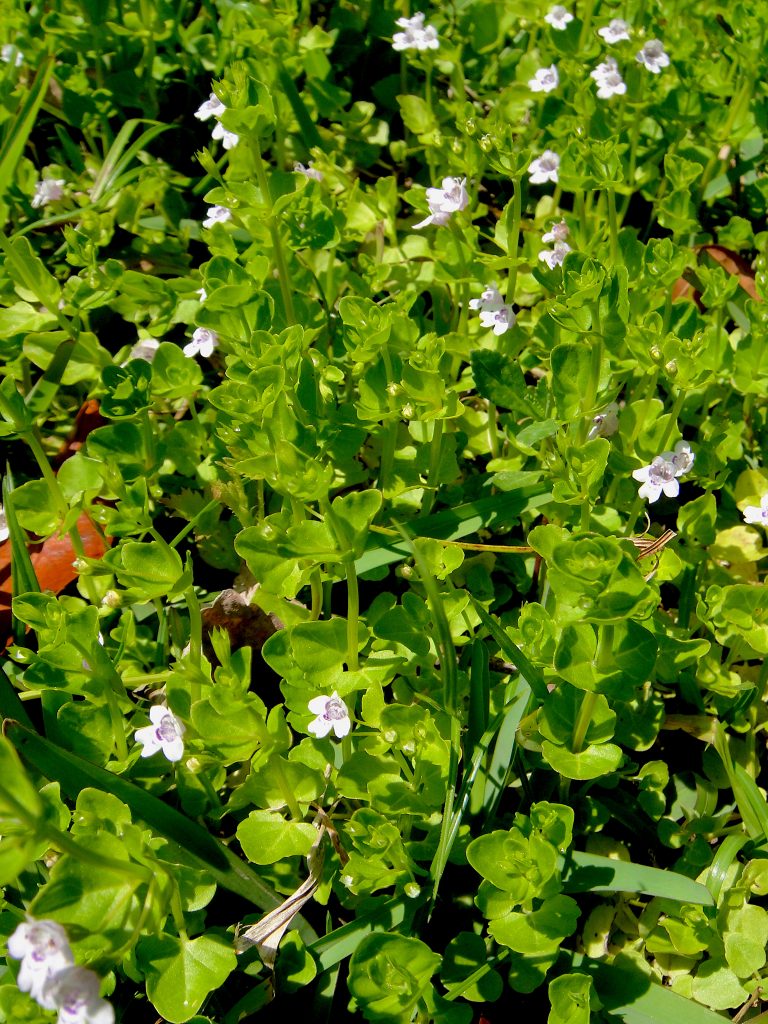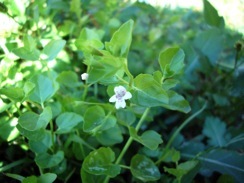
It’s a native little mint with a variety of names. Photo by Green Deane
The Mighty Minty Micromeria Brownei
Sometimes in central Florida you will drive past a car accident on the interstate, or another road, and smell mint. You’re not having sensory crossover: That’s Micromeria Brownei, aka Clinopodium Brownei. (klin-oh-POH-dee-um brown-ee-eye)
Micromeria Brownei (my-kro-MARE-ri-a) is a minuscule mint that likes swales and other wet places. It blooms all year and prefers its feet damp most of the time, hence its reference as the “aquatic mint.” Some botanists say M. Brownei var. pilosiuscula (pye-loh-see-USK-yew-lus) can be found only in central and northern Florida, others place it in southern Georgia as well and around the Gulf of Mexico into Central America. Native flower books don’t list it as a native and Micromerias are found around the world, even in wet spots of desert countries.
This writer remembers many car accidents on Interstate 4 at State Road 46 in Sanford, Florida. Though the area has been re-engineered, that interstate’s intersection was a common spot of accidents and the median at the time was low. For about a half a mile to the south the entire center median was nothing but Micromeria brownei and a few other wet-footed plants. Any car that skidded or drove through that area threw up a hint of mint that lasted for days.
M. brownei has many common names. Browne’s Savory seems to be an old standby whereas Creeping Charlie is a favorite with the aquarium, build-a-pond crowd. St. John’s Mint is a recent and becoming popular name (the river that flows through the peninsula of Florida is the St. John’s.) Micromera means little parts, or in this case little leaves and flowers. It is also called Clinopodium brownei, which means “slope footed.” It was named after Patrick Browne (1720-1790), who first desribed it as “THYMUS i. Minimus herbaceus, foliis orbiculatis crenatis, floribus singularibus ad alas.” Quite a lot for such a little mint. Browne’s major work was The Civil and Natural History of Jamaica (1756). Pilosiuscula means somewhat hairy but as I write these words I have a living specimen with me and it is nearly hairless. Some references say the mint is very hairy. But even under magnification 30x the M. Brownei I have is not hairy. If it is hairy the hair is extremely small, and “somewhat hairy” is an overstatement… or is it statemint?
If you live in the west coast states of the United States, you can use Clinopodium douglasii, or Yerba Buena, which was also the original name of San Francisco until 1847. It is slightly more tolerant of dry conditions. It can be found as far east as western Montana. Again, making tea is a matter of taste when it comes to amounts, and again, it should be avoided by pregnant women
Green Deane’s “Itemized” Plant Profile
IDENTIFICATION: A very sprawling, creeping and erect perennial with square stems and opposite leaves. Stems are nearly hairless, flowers have purple splotches on petals and in throat. Entire plant fragrant
TIME OF YEAR: Available year round, blossoms year round.
ENVIRONMENT: Grows in all kinds of soil as long as it is constantly damp, full sun to partial shade.
METHOD OF PREPARATION: Use fresh or dried, make a very nice tea or flavoring.


